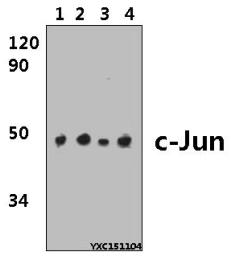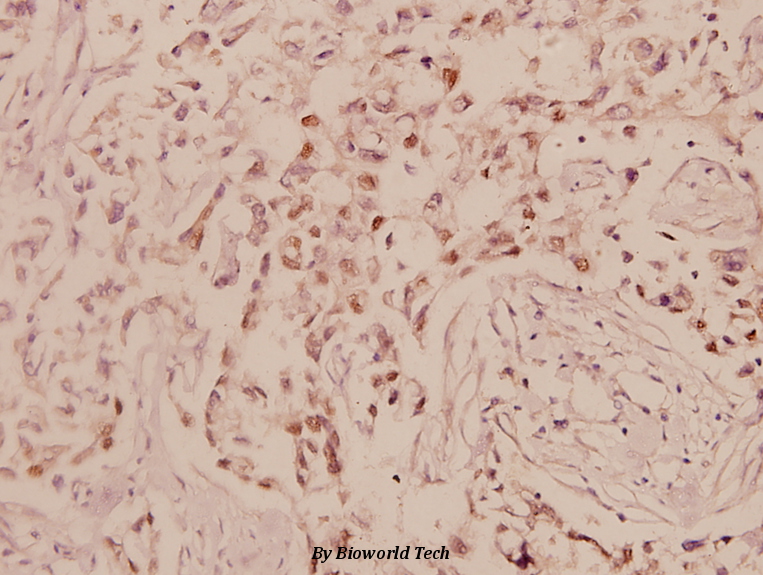Product Name :
c-Jun (G67) polyclonal antibody Background :
The c-Jun proto-oncogene was first identified as the cellular homolog of the avian sarcoma virus v-Jun oncogene. The c-Jun protein, along with c-Fos, is a component of the AP-1 transcriptional complex. c-Jun can form either Jun/Jun homodimers or Jun/Fos heterodimers via the leucine repeats in both proteins. Homo- and heterodimers bind to the TGACTCA consensus sequence present in numerous promoters and initially identified as the phorbol ester tumor promoter response element (TRE). Two additional genes, Jun B and Jun D, have been shown to be almost identical to c-Jun in their C-terminal regions, which are involved in dimerization and DNA binding, whereas their N-terminal domains, which are involved in transcriptional activation, diverge. All three form heterodimers among themselves and with c-Fos and other members of the Fos gene family. Product :
Rabbit IgG, 1mg/ml in PBS with 0.02% sodium azide, 50% glycerol, pH7.2 Storage&Stability :
Store at 4°C short term. Aliquot and store at -20°C long term. Avoid freeze-thaw cycles. Specificity :
c-Jun (G67) polyclonal antibody detects endogenous levels of c-Jun protein. Immunogen :
Synthetic peptide, corresponding to amino acids 41-90 of Human c-Jun. Conjugate :
Unconjugated Modification :
Unmodification
c-Jun (G67) polyclonal antibody Background :
The c-Jun proto-oncogene was first identified as the cellular homolog of the avian sarcoma virus v-Jun oncogene. The c-Jun protein, along with c-Fos, is a component of the AP-1 transcriptional complex. c-Jun can form either Jun/Jun homodimers or Jun/Fos heterodimers via the leucine repeats in both proteins. Homo- and heterodimers bind to the TGACTCA consensus sequence present in numerous promoters and initially identified as the phorbol ester tumor promoter response element (TRE). Two additional genes, Jun B and Jun D, have been shown to be almost identical to c-Jun in their C-terminal regions, which are involved in dimerization and DNA binding, whereas their N-terminal domains, which are involved in transcriptional activation, diverge. All three form heterodimers among themselves and with c-Fos and other members of the Fos gene family. Product :
Rabbit IgG, 1mg/ml in PBS with 0.02% sodium azide, 50% glycerol, pH7.2 Storage&Stability :
Store at 4°C short term. Aliquot and store at -20°C long term. Avoid freeze-thaw cycles. Specificity :
c-Jun (G67) polyclonal antibody detects endogenous levels of c-Jun protein. Immunogen :
Synthetic peptide, corresponding to amino acids 41-90 of Human c-Jun. Conjugate :
Unconjugated Modification :
Unmodification
-
 Western blot (WB) analysis of c-Jun (G67) polyclonal antibody at 1:500 dillution Lane1:HEK293T whole cell lysate(40μg) Lane2:NIH-3T3 whole cell lysate(40μg) Lane3:PC12 whole cell lysate(40μg) Lane4:H9C2 whole cell lysate(40μg)
Western blot (WB) analysis of c-Jun (G67) polyclonal antibody at 1:500 dillution Lane1:HEK293T whole cell lysate(40μg) Lane2:NIH-3T3 whole cell lysate(40μg) Lane3:PC12 whole cell lysate(40μg) Lane4:H9C2 whole cell lysate(40μg) -
 Immunohistochemistry (IHC) analyzes of c-Jun (G67) pAb in paraffin-embedded human breast carcinoma tissue at 1:100.
Immunohistochemistry (IHC) analyzes of c-Jun (G67) pAb in paraffin-embedded human breast carcinoma tissue at 1:100.
Cyclic fluid shear stress promotes osteoblastic cells proliferation through ERK5 signaling pathway
PMCID: Pubmed No.:22286747
Exploration of 1-(3-chloro-4-(4-oxo-4H-chromen-2-yl)phenyl)-3-phenylurea Derivatives as Selective Dual Inhibitors of Raf1 and JNK1 Kinases for Anti-tumor Treatment
PMCID: Pubmed No.:23260578
Low expression of glucocorticoid receptor alpha isoform in adult immune thrombocytopenia correlates with glucocorticoid resistance
PMCID: Pubmed No.:23435844
microRNA-23a,-27a and-24 synergistically regulate JAK1/Stat3 cascade and serve as novel therapeutic targets in human acute erythroid leukemia
PMCID: Pubmed No.:27086927
microRNA-23a,-27a and-24 synergistically regulate JAK1/Stat3 cascade and serve as novel therapeutic targets in human acute erythroid leukemia
PMCID: Pubmed No.:27086927
Bioworld Biotech only provide peptides for our antibodies and do not provide additional peptide customization services.
Price/Size :
USD 368/1mg/vial
Tips:
For phospho antibody, we provide phospho peptide(0.5mg) and non-phospho peptide(0.5mg).Describe :
Blocking peptides are peptides that bind specifically to the target antibody and block antibody binding. These peptide usually contains the epitope recognized by the antibody. Antibodies bound to the blocking peptide no longer bind to the epitope on the target protein. This mechanism is useful when non-specific binding is an issue, for example, in Western blotting (WB) and Immunohistochemistry (IHC). By comparing the staining from the blocked antibody versus the antibody alone, one can see which staining is specific; Specific binding will be absent from the western blot or IHC performed with the neutralized antibody.Formula:
Synthetic peptide was lyophilized with 100% acetonitrile and is supplied as a powder. Reconstitute with 0.1 ml DI water for a final concentration of 10 mg/ml.The purity is >90%,tested by HPLC and MS.
Storage:
The freeze-dried powder is more stable. For short time at 2-8°C. For long term storage store at -20°C.
Note :
This product is for research use only (RUO only). Not for use in diagnostic or therapeutic procedures.
 c-Jun (G67) polyclonal antibody
c-Jun (G67) polyclonal antibody  Datasheet
Datasheet COA
COA MSDS
MSDS SHIP
SHIP